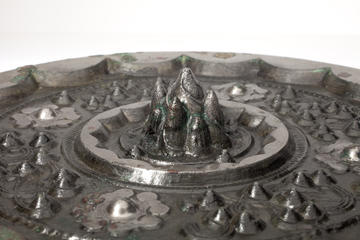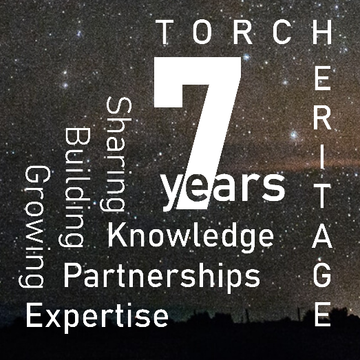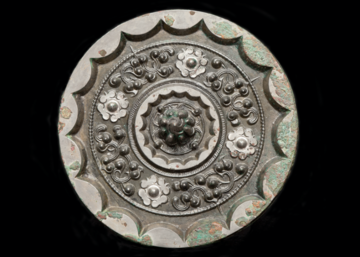Bronze Mirrors: Reflections of China
A Curatorial Summer Internship at Compton Verney
The Heritage Partnerships Team and the Oxford University Heritage Network (OUHN), working closely with the Oxford University Careers Service, set up and funded this four-week summer internship with Compton Verney. This internship was funded through the Higher Education Innovation Fund (HEIF). Since 2014, when we first established this collaboration, Compton Verney has hosted seven interns from the University of Oxford.
Back in July, when I just flew back to Shanghai and was quarantined in the hotel, I received an email invitation to an interview for the summer internship. I was lifted up and started to prepare for it. Luckily, I got the precious chance to work as a research intern at Compton Verney on the fabulous Chinese bronze collections.
My background in archaeology and anthropology equips me with the knowledge and methodology to explore the cultural codes embedded in these objects thousands of years ago. Various patterns on the back of bronze mirrors reflect people’s changing religious beliefs and the cultural environment; inscriptions carved stroke by stroke denote people’s worship for the ancestors; the change of vessel shapes tells the story of cultural exchange between the north and the Central Plain. Unlike the research based on the second-hand resources, the opportunity of working in the gallery provided me with a different learning experience: exploring the objects’ purchase and conservation history through the firsthand archives and documents. Through the research into their provenance and conservation history, the social lives and trajectories of these antiques are generally unfolded alongside my internship journey.
Due to the pandemic, the internship was remote. It was a little bit weird that I had to work alone in front of my computer with no colleagues nearby. I also faced with the problem of time differences; I was in China and was seven hours ahead of the time in the UK. Luckily, these changes did not influence my work and even allowed more flexibility. The research was largely independent, but I still had opportunities to stay connected with my colleagues. I had weekly meetings with my supervisor, Amy Orrock, senior curator at the gallery, who supported my work and welcomed me into the community. Besides meetings with Amy, during which I would report my progress, and she would give me feedback on the object reports I sent each week, I also had the chance to attend the staff meeting and learn about the operation of the gallery from all aspects, beyond the academic sector. I worked in several museums before, but this was my first time to attend a meeting with staff from different departments, including those responsible for finance, facilities and public education, especially during this exceptional time when cultural institutions like museums and galleries are faced with new challenges.
Regarding my research, there are 11 Chinese bronze mirrors in the collection at Compton Verney. The earliest one can be dated back from the Warring States period (around 475 BC – 221 BC). Most date from the Han dynasty and the Tang dynasty, the two most prosperous periods in the history of China. In daily life, we see ourselves in the mirror all the time; but the quality, techniques, patterns and designs of these bronze mirrors also reflect the conditions of China at a specific time. For example, the patterns of the Han mirrors were about mythology and religion, while the Tang mirrors focused more on depicting plants or animals.

Detail of xingyun (star and cloud) mirror, Western Han dynasty. © Compton Verney, photo by Jamie Woodley Photography.
With bronze mirrors, one side of the mirror will be highly polished and used for reflection, while the other side will be decorated with various patterns, including mythical beasts, immortals, stars, clouds, geometrical shapes and plants. There is a knob at the centre of each mirror and it is always decorated, sometimes as a mountain and sometimes as an animal. The knob is called the mirror button, and if you look closely at the mirror button from the side view, you will find a hole on it. This allows for a cord to be threaded through the hole, so that the mirror can be easily fixed on a stand.
How did people in ancient China use these mirrors? In the earlier period, like other bronzes, mirrors were used as a ritual object in the sacrifice; in the Eastern Zhou dynasty, most mirrors were still precious and only accessible to royal families and aristocrats. With the development of the handicraft industry, bronze mirrors gradually became an everyday object and were available to the common people. To keep the mirror free from dust, people invented mirror cases made of silk or wood, which have been excavated in the tomb of the Han dynasty. Once used for a while, the reflection side of a bronze mirror will get cloudy and need to be polished. In the Qing dynasty, bronze mirrors were gradually replaced by glass mirrors introduced from Europe.
Among all the mirrors in our collection, my favourite one is the xingyun (star and cloud) mirror for its special decoration. Early archaeologists gave the mirror this name because if you look down at this mirror, the bosses look like stars spread over sky while the curves cast in relief are like the fast-moving clouds floating between the stars. However, if you look at the pattern from a side view, you will have a different finding. The bosses look like numerous hills and the mirror button in the middle is like the highest mountain among all these hills. The mountain is delicately cast, and you can see details of its texture clearly.
You can find out more about the Chinese collection of Compton Verney here.
Wenrui Li is studying for the MSc in Visual, Material and Museum and Anthropology at the University of Oxford. Before this, she obtained her BA in archaeology at Nanjing University (China). She is interested in photographs, heritage and material culture, especially objects in our contemporary lives, and is currently researching the changing materiality of family photographs in China. She hopes to pursue a career in the heritage sector in the future.
TORCH Heritage Programme Homepage


Xingyun (star and cloud) mirror, Western Han dynasty (206 BC-AD 24). © Compton Verney, photo by Jamie Woodley Photography.


